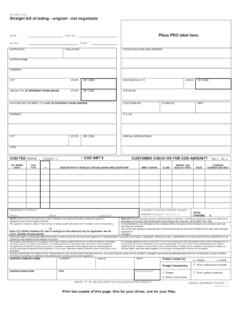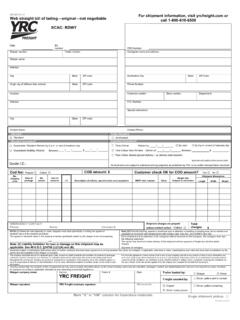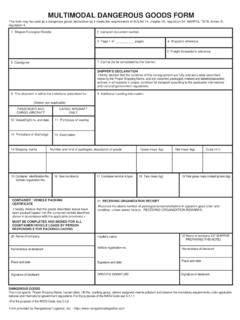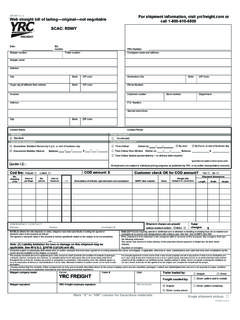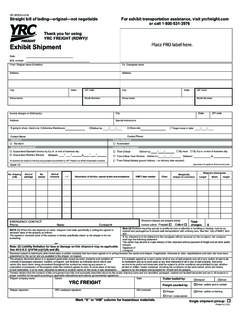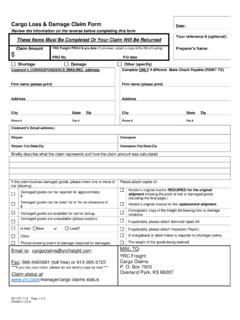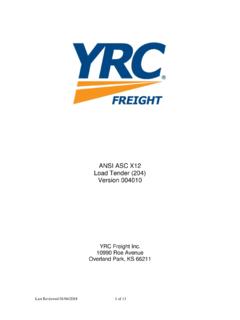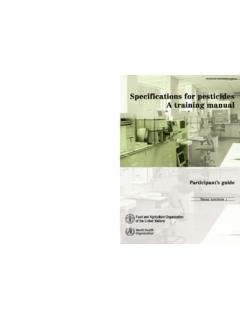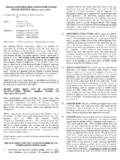Transcription of A SHIPPER'S - YRC Freight
1 A SHIPPER'S . GUIDE TO PACKAGING. A Shippers Guide TO Packaging shipper Responsibilities Shippers are responsible for proper packaging marking and labeling descriptions on all shipper documentation Shippers must follow all existing tariff and shipping regulations related to their product. Proper Packaging Introduction Shipments must be properly packed to ensure damage-free transportation with ordinary care in handling. The proper packaging of goods for transportation requires a good understanding of the product and distribution environment. There are three essentials to any package: 1.) outer packaging 2.) inner packaging 3.) sealing method Understanding and following these packaging guidelines can help ensure damage-free Freight movement. Hazards of distribution Below are the most common hazards present in Freight transportation.
2 These are normal hazards of distribution and therefore must always be considered when preparing a shipment for LTL. transportation. Punctures and Abrasion: Occurs when the package shifts or comes in contact with other packages or material handling equipment during transportation. They can also be the result of improper or insufficient internal packaging that does not prevent the contents from shifting. Compression: Occurs when external forces are applied to the sides, faces or corners of a package. Stacking, shock, vibration, material handling equipment and tie-down straps all generate compression forces that may result in package or product damage. Proper packaging will prevent damage due to normal compression. Environmental exposures: High and low humidity can result in condensation or corrosion, and it can greatly reduce the rigidity and compression resistance of paper-based products such as cardboard containers.
3 Temperature extremes can range from sub zero to temps in excess of 100 degrees F. and can dramatically affect the performance characteristics of packaging material. Other common environmental exposures include, but are not limited to, dirt, dust, odors and precipitation. If a product or package would be considered damaged if exposed to these hazards, the shipper must take extra measures to ensure the packaging can protect the shipment. 1. Shipment Handling: Proper cushioning can reduce damage caused by the shock incurred during handling and over the road transportation. It is important to note that shipments will most likely be handled with a forklift at some point during distribution . Proper packaging must protect the contents from the drops and impacts commonly associated with handling operations.
4 Shock: Occurs during handling and transportation as a result of impacts with mechanical handling or road conditions. Proper cushioning can reduce damage caused by shock. Most products will require some level of shock protection to prevent damage during normal handling and transportation. Vibration: Is normal occurrence in over the road transportation. Proper cushioning can absorb and reduce the negative effects vibration can have on products. The National Motor Freight Classification. (NMFC). Integral to the National Motor Freight Classification (NMFC) are internationally recognized specifications, rules and requirements for the proper packaging of goods moving by motor carrier. The packaging provisions in the NMFC fall into three basic categories: 1. General packaging definitions and specifications 2.
5 Specifications for packages that have been approved expressly for the transportation of certain commodities 3. Performance-based packaging criteria The general packaging definitions and specifications are for commonly used packages, such as bags, crates, drums and of course fiberboard boxes. These provisions are found in various rules within the NMFC and set requirements for the construction and integrity of the package. For instance, the Item 222 series of rules enumerates the requirements for fiberboard boxes, including size and weight limits, the strength of the fiberboard used, and the box manufacturer's certificate that must appear on all conforming boxes. The NMFC also provides specifications for literally hundreds of packages that are authorized expressly for the transportation of certain commodities.
6 These are essentially exceptions to the general packaging definitions and specifications, and each is assigned a unique package number. Through laboratory testing and/or actual test shipments, these numbered packages have been proven to offer adequate protection in the motor carrier environment for the transport of particular commodities. Examples of package design requirements are: Item 222 Fiberboard Boxes Item 245 Crate Design Requirements Item 255 Drums Item 265 Pallets Item 258 Plastic Pails These are only a few examples. Literally every package design is reviewed in the NMFC. Shippers are encouraged to refer to the NMFC for all packaging requirements. 2. General packaging requirements are addressed in Item 680. A summary includes: Item 680 PACKING OR PACKAGING-GENERAL.
7 Sec. 1. (a) The definitions of or specifications for packing requirements are named in: (1) Items 200. through 299, (2) numbered packages and (3) Note references. The material and construction specifications therein are minimum requirements and must be observed. Whether or not interior packing devices are a part of specific requirements, interior packing devices must be provided where such are necessary to afford adequate protection against damage to the contents of a container. Articles or articles and necessary interior packing devices must reasonably occupy the full cubic capacity of the outer shipping container Sec. 7. (b) Articles in packages or shipping forms, as authorized in individual item descriptions, will be accepted when unitized or secured on lift truck skids, pallets or platforms meeting the requirements of Item 265.
8 Unless otherwise provided, when in the specifications of numbered packages or in individual item descriptions articles are required to move on lift truck skids, pallets or platforms, such skids, pallets or platforms must meet the requirements of Item 265. Except where required in individual item descriptions, it is recommended that articles unitized or secured on lift truck skids, pallets or platforms not overhang the skid, pallet or platform deck. Selecting Corrugated Fiberboard Boxes Even though CFBs are the most common type of shipping container, many people do not understand the strengths and weaknesses of the package. Corrugated fiberboard can degrade over time, losing as much as 50 percent of its strength after sitting just six months. Humidity and moisture also cause major problems for this paper-based product.
9 A relative humidity of 90 percent can weaken CFB by as much as 60 percent. Most CFBs do not maintain enough strength and integrity to be reused and should be thought of as single-use packages. The greatest compression strength of CFB is within 1 of the edges created by two adjacent panels. The length of the dotted arrow is proportional to the load bearing ability at that point. 3. NMFC Item 222 addresses the requirements for CFBs. Box makers' certificates (BMC) are typically found on the bottom flaps. The BMC states the maximum size (length + width + height) and the maximum weight the box can hold based on the material used to construct it. These size and weight limits have long been the minimum requirements cited by the NMFC. The BMCs indicate the maximum size and the maximum weight allowed.
10 Exceeding these limits could result in a damage claim being denied. Box Maker's Certificate Inner Packaging NMFC Item 680 notes Whether or not interior packing devices are a part of specific requirements, interior packing devices must be provided where such are necessary to afford adequate protection against damage to the contents of a container. Articles or articles and necessary interior packing devices must reasonably occupy the full cubic capacity of the outer shipping container.. Many products are available to meet the NMFC requirements regarding inner packaging. Some examples are noted below. The shipper should carefully review their product and select the most effective inner packaging material. Inner Packaging Materials Bubble Wrap Bubble wrap is a light and flexible packaging material made of low-density polyethylene, ideal to protect fragile and irregularly shaped products.

